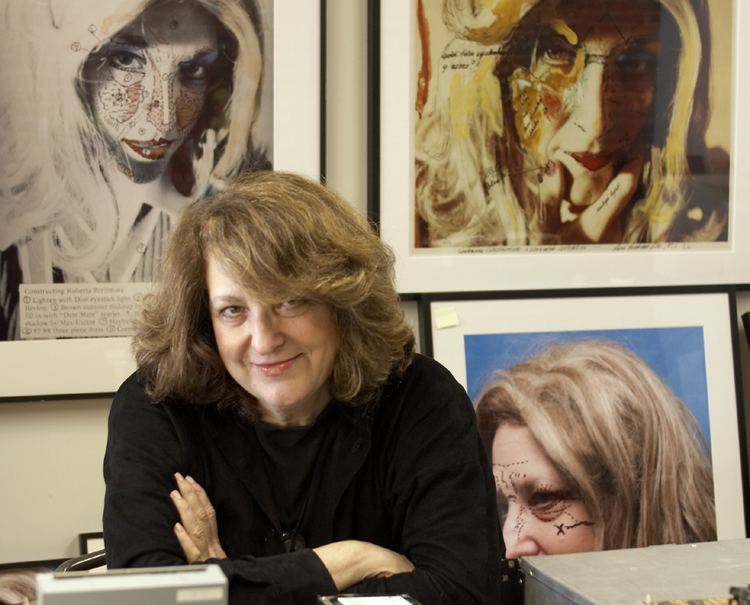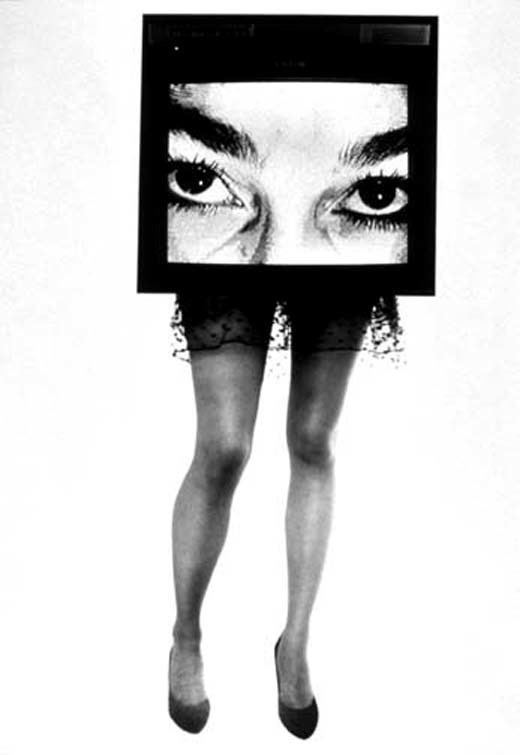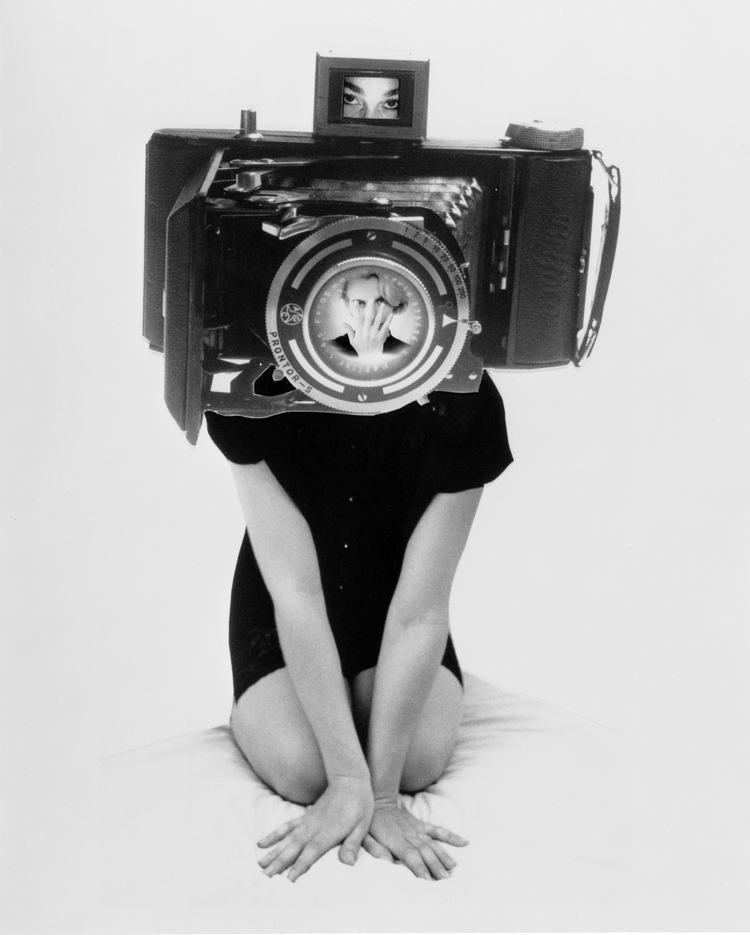Nationality American Role Artist Name Lynn Leeson | Website Lynn Hershman Leeson Occupation Artist, filmmaker | |
 | ||
Notable work America's Finest, Synthia, CybeRoberta, Tillie, Agent Ruby, DiNA, Conceiving Ada, Teknolust, Strange Culture, !Women Art Revolution Books !Women Art Revolution: !W.A.R., Paranoid mirror Awards Guggenheim Fellowship for Creative Arts, US & Canada Nominations Independent Spirit Someone to Watch Award Movies !Women Art Revolution, Teknolust, Strange Culture, Conceiving Ada, Desire Inc Similar People Tilda Swinton, Carrie Brownstein, Thomas Jay Ryan, Karen Black, Judy Chicago | ||
Lynn hershman leeson civic radar artist talk
Lynn Hershman Leeson (born 1941) is an American artist and filmmaker. Her work combines art with social commentary, particularly on the relationship between people and technology. Leeson's work in media-based technology helped legitimize digital art forms.
Contents
- Lynn hershman leeson civic radar artist talk
- Lynn hershman leeson selected works
- Work
- Alter ego
- LORNA
- Agent Ruby
- Films and documentaries
- Retrospectives
- Grants and awards
- References

Lynn hershman leeson selected works
Work

Leeson's work has as its themes: identity in a time of consumerism, privacy in an era of surveillance, interfacing of humans and machines, and the relationship between real and virtual worlds. Her work grew out of an installation art and performance tradition, with an emphasis on interactivity. With a practice spanning more than 40 years, Leeson has worked in performance, moving image, drawing, collage, text-based work, site-specific interventions, and later new media / digital technologies, and interactive net-based works.

Her projects explore technology in digital media and science. Leeson was the first artist to launch an interactive piece using Videodisc, a precursor to DVD (Lorna, 1983–84), as well the first artist to incorporate a touch screen interface into her artwork (Deep Contact, 1984-1989). Her networked robotic art installation (The Difference Engine #3, 1995-1998) is an example of her tendency to expand her artwork beyond the traditional realms of art.

Work by Lynn Hershman Leeson is featured in the public collections of the Museum of Modern Art, the William Lehmbruck Museum, the ZKM (Zentrum fur Kunst und Medientechnologie), the Los Angeles County Museum of Art, the National Gallery of Canada, di Rosa, the Walker Art Center and the University Art Museum, Berkeley, in addition to the private collections of Donald Hess and Arturo Schwarz, among many others. Commissions include projects for the Tate Modern, San Francisco Museum of Modern Art, de Young Museum, Daniel Langlois and Stanford University, and Charles Schwab.
Alter ego

From 1974 until 1978, Leeson ‘developed’ a fictional persona and alter ego of "Roberta Breitmore." It consisted not only of a physical self-transformation through make-up, clothing, and wigs, but a fully-fledged personality existing over an extended period of time and whose existence could be proven in the world through physical evidence: from a driver’s license and credit card to letters from her psychiatrist.

This was later taken to further lengths when Leeson introduced another three ‘Robertas’, by hiring other performers to enact her character. These ‘clones’ of Roberta adopted the same look and attire, engaged in some of Roberta’s correspondence and also went on some of Roberta (Leeson’s) dates. Towards the end, the ‘original’ Roberta, withdrew from her character leaving the three ‘clones’ to continue her work, until they were retired in a performance at the Palazzo dei Diamanti in Ferrara, Italy in 1978, during an exorcism at the grave of Lucrezia Borgia. What remains are the physical artefacts of any life: documentation and personal effects such as legal and medical documents and a diary).
Between 1995–2000 Roberta transformed into the CybeRoberta, an interactive artificial intelligent sculpture on the web. In 2006 Roberta Breitmore developed into a character in Second Life. After Stanford University acquired her archive, Leeson worked with Henry Lowood (Stanford Humanities Lab) to convert parts of the archive into something for a broader public. They worked to recreate and re-enact both Roberta Breitmore and The Dante Hotel in a virtual space.
LORNA
LORNA was an early project of Leeson's. The first interactive laser artdisk, LORNA tells the story of an Agoraphobic woman. Viewers have the option of directing her life into several possible plots and endings. LORNA never left her one-room apartment. As LORNA watched the news and ads, she became fearful, afraid to leave her tiny room. Viewers were invited to liberate LORNA from her fears, using remote control units.
The plot has multiple variations that can be seen backwards, forwards, at increased or decreased speeds, and from several points of view. There is no hierarchy in the ordering of decisions. And the icons were often made of cut-off and dislocated body parts such as a mouth, or an eye.
Agent Ruby
In 2001, Leeson created the "Agent Ruby" for the SFMOMA . Since that time Agent Ruby has conversed with online users, which has shaped her memory, knowledge, and moods. In 2013 the SFMOMA presented Lynn Hershman Leeson: The Agent Ruby Files. This digital and analog presentation reinterprets dialogues drawn from the decade-long archive of text files of Agent Ruby’s conversations with online users and reflects on technologies, recurrent themes, and patterns of audience engagement.
Films and documentaries
A 1990 documentary, Desire Inc. features a series of seductive television ads in which a sexy woman asked for viewers to call her.
Leeson's three feature films - Strange Culture, Teknolust, Conceiving Ada - have been part of the Sundance Film Festival, the Toronto International Film Festival and The Berlin International Film Festival, among others, and have won numerous awards.
In 2011 Hershman released the ground-breaking !Women Art Revolution, a feature-length documentary about the Feminist art movement in the United States. According to Leeson:
The films are all about loss and technology. Ada Lovelace invented computer language, but was never credited and was basically erased from history. Teknolust is about artificial intelligence clones: the bots that escape into reality and interact with human life, in effect a symbiosis between technological life and human life, and how the two can marry. Strange Culture again was about misidentity, where the media created a fictional character that they blame this crime on, rather than the actual person. All of these works are about erasure of identity and how technology adds to it and creates it. And how you can defeat that.
As part of her 2014 exhibition "How To Disappear," she premiered her video The Ballad of JT LeRoy, examining Laura Albert's use of the literary persona JT LeRoy. Reflecting on the parallels between JT LeRoy and Roberta Breitmore, Hershman Leeson has commented:
The concept of an alter ego is not new at all. Writers have been protecting themselves in that way for centuries. Mary Shelley did it. Of course Laura took this practice further and I think that was very smart and I do not think she deserves the kind of condemnation that she got. If I had done the Roberta thing ten years later, I would have faced the same problems.
Retrospectives
In 2007 a retrospective at the Whitworth Art Gallery in Manchester, Autonomous Agents, featured a comprehensive range of the artist's work - from the Roberta Breitmore series (1974–78) to videos from the 1980s and interactive installations that use the Internet and artificial intelligence software. Her influential early ventures into performance and photography are also featured in the current touring exhibition WACK! Art and the Feminist Revolution, organized by the Los Angeles Museum of Contemporary Art. The Art and Films of Lynn Hershman Leeson: Secret Agents, Private I, was published by The University of California Press in 2005 on the occasion of another retrospective at the Henry Gallery in Seattle.
In 2014 a retrospective at The ZKM Museum of Contemporary Art in Karlsruhe, Germany, "Civic Radar", has realized the first retrospective which not only ensures an overview of all creative phases in Lynn Hershman Leeson’s oeuvre but also the most recent productions of this innovative artist. While encompassing a wide body of Hershman's work throughout the years, as an exhibition, "Civic Radar" highlights Hershman's interest in technology, looking closely at artificial intelligence and genetic modification. In 2017, "Civic Radar," Hershman's retrospective from ZKM was hosted at the Yerba Buena Center for the Arts in San Francisco, California.
Grants and awards
Lynn Hershman Leeson has been honored with grants from Creative Capital, The National Endowment for the Arts, Nathan Cummings Foundation, Siemens International Media Arts Award, Prix Ars Electronica, and Alfred P Sloan Foundation Prize for Writing and Directing. In 2009 she was the recipient of a John Simon Guggenheim Memorial Foundation Fellowship. Also in 2009, she received the SIGGRAPH Distinguished Artist Award. The Digital Art Museum in Berlin recognized her work with the d.develop digital award (ddaa) for Lifetime Achievement in the field of New Media in 2010. Her work was recently included in Arthur and Marilouise Kroker's Top Ten for the January 2013 issue of Artforum.
In 2014, IFP Pixel Market Prize went to The Infinity Engine starring Tilda Swinton, directed by Lynn Hershman Leeson in collaboration with producer Lisa Cortes, whose credits include the Academy Award and Sundance Film Festival winning film Precious. The Infinity Engine is an installation, film and online interactive website. The prize comprises a six-month fellowship at the Media Center and an invitation to participate in next year’s No Borders programme.
Leeson was also featured in the Women's eNews "21 Leaders for the 21st Century" special in 2014 for her role in empowering young female artists to strengthen their artistic voices. Her documentary !W.A.R. raises awareness for the fact that the art world is a male-dominated realm and explores the many influential works of female artists over the decades.
Hershman Leeson served as Chair of the Film Department at the San Francisco Art Institute, as Professor Emeritus at the University of California, Davis, and as an A. D. White Professor at Large at Cornell University. She is the 2013-2014 Dorothy H. Hirshon "Director in Residence" at The New School.
In 2004, Stanford University Libraries acquired Hershman Leeson's working archive. Stanford also acquired a collection of the interviews compiled for Hershman Leeson's 2010 documentary !Women Art Revolution.
